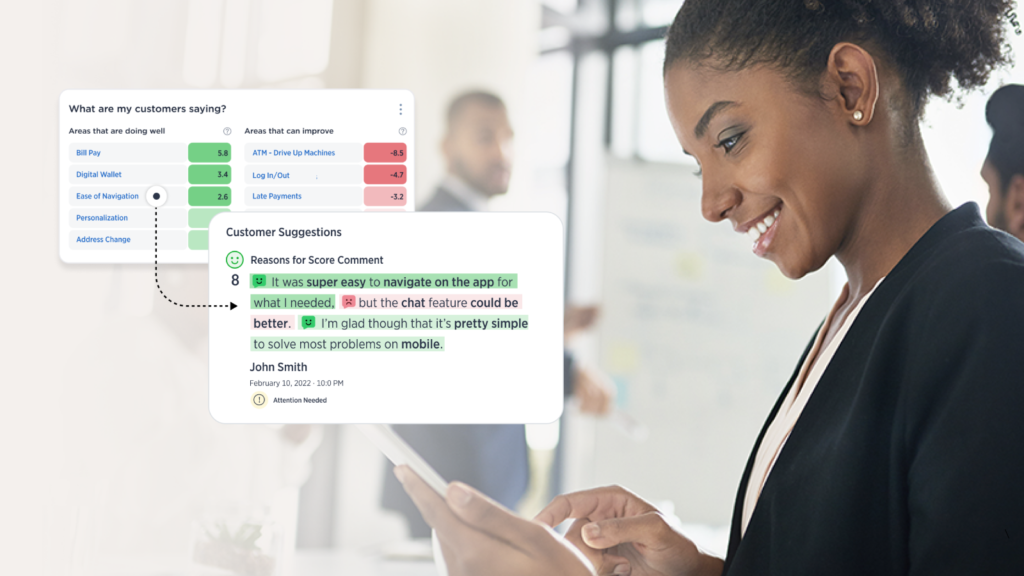Looking for a text analytics solution? Here’s what needs to be in your request for proposal (RFP) while making the decision for your business.
Crafting a request for proposal, also known as an RFP, can be a delicate balancing act between business needs and the desire for the latest-and-greatest innovations. Because text analytics solutions are constantly adding and updating new features, it can feel almost impossible to distinguish ‘marketing speak’ from actual impactful features and use cases.
Text Analytics Features: Baseline Requirements
As you consider text analytics solutions, ensure that the solution under consideration supports these baseline requirements: Topic Categorization, Sentiment Analysis, Machine Learning (ML), Model Support for Multiple Languages, and Natural Language Processing (NLP).
If the text analytics solutions you’re assessing don’t have these capabilities, or if these are the only features being highlighted, be wary. Not only do these need to be a standard part of any text analytics solution, but we also recommend vetting each according to your use cases.
Once you have established that the solution being considered has these capabilities, turn your attention to capabilities that will take your business to the next level.
Text Analytics Capabilities You Should Add to Your Next RFP
Unsurprisingly, the key to writing an RFP for a differentiated, best-in-class text analytics solution is to both know and ask for differentiated capabilities. Some of these capabilities to add to your RFP for a best-in-class text analytics solution include:
- Omnichannel Data Integration
- AI-Driven Natural Language Understanding (NLU)
- Low Cost of Model Maintenance
- Personalized Reporting that Drives Engagement
- Support for Real-Time Use Cases
- Scalability Across Multi-Market and Multilingual Teams
Let’s dive deeper into each of these to uncover the reasons you need these capabilities and how they can generate value for your business.
#1. Omnichannel Data Integration
RFPs focused on text analytics often do not mention omnichannel data integration or analytics. When they do, the focus is typically on the number of integrations offered. Feedback on your business comes from everywhere — from calls to video to social – but data connectors and integrations are just the beginning of an omnichannel data model.
Best-in-class omnichannel solutions should be able to natively ingest and organize disparate data sources from across your business so that unified analytics models can be easily applied. In order to take an omnichannel approach to experiences, solutions must aggregate all experiences into a comprehensive profile that represents every bit of feedback a customer or account has given to your business. This aggregation allows for meaningful patterns to emerge so that you can calculate the total impact of issues on customers and employees.
#2. AI-Driven Natural Language Understanding (NLU)
RFPs may describe natural language processing (NLP) and categorization capabilities in some capacity, but increasingly there are requests for emotional analysis and effort scoring capabilities as well. Emotions and effort are often considered part of natural language understanding (NLU) or natural language interpretation (NLI). But, as you might imagine, there is a difference in having NLU models and deploying them with effectiveness and efficiency.
Common NLU models include effort scoring, emotion, empathy, and sentiment, but you should also consider more advanced models that drive actionable workflows — such as risk of customer churn or employee attrition. It’s important to validate how these models are built and maintained during your evaluation process to ensure that what you see in a demonstration will carry over into your live programs.
You should seek out NLU engines with a strong AI foundation in NLU models that will allow for faster model training, quicker deployment of new models, and reduce the number of rules-based topic models that need to be manually maintained. Ultimately, this enables your business to act more effectively on experiences without having to use full-time employee hours to maintain accuracy or models.
#3. Low Cost of Model Maintenance
If a tool requires constant upkeep over the duration of a contract, expect to incur a significantly higher cost of ownership beyond the sticker price. In your text analytics RFP, you should ask questions specifically about how much time and manual effort will need to be spent by your team or by a vendor servicing team to maintain high levels of accuracy for all these models.
One important factor to consider is how many models – categorization, sentiment, advanced NLU – will be based on manual rules compared to AI. A healthy balance will ensure that you have the flexibility to build precise models while relying on no-code or low-code training to maintain the accuracy and quality of your text analytics. This healthy balance will ensure that you’re not reallocating significant employee time from improving experiences to maintaining the solution.
#4. Personalization Features That Drive Engagement
Engagement and adoption are critical to the success of an analytics solution — a high volume of regular users results in more actions being taken and more opportunities being addressed across your business. Personalized reporting by user and role guarantees that the right people have access to the exact information they need without redundant details that may cause analysis paralysis.
Personalized reporting is more than the ability to build different dashboard views that can be shared with individuals across the organization. Painless, personalized text analytics and reporting leads to more engagement, which encourages other users throughout the organization to adopt the solution. To be effective, personalized reporting must be able to account for your organization’s shifting structure and automatically adjust as people change roles within your organization.
You should validate how vendors manage complex organizational hierarchies as part of the evaluation process. Additionally, think about the different systems of work — such as desktops, mobile devices, and CRMs like Salesforce — that your employees already engage with. Personalization is thus a huge feature that you cannot afford to ignore in order to purchase a text analytics solution that seamlessly integrates into your systems of work.
#5. Support for Real-Time Use Cases
Saving a few seconds makes all the difference for customer experience and contact center teams. Your text analytics solution should empower you to automatically alert the right people at the right time based on emerging trends and new opportunities, prioritize support tickets, automate agent scoring, and support workflows in real time.
Real-time capabilities are now necessary to surface insights and solicit action from thousands — if not millions — of feedback records. As a result, your text analytics solution should surface action-oriented insights that are prioritized automatically based on whether you can act on them.
Real-time capabilities proactively call attention to what matters most, saving your business time and enabling quick delivery of key actionable insights. The effect is not only for you to have a more efficient and effective experience management program, but also to ultimately save money.
#6. Scalability Across Multi-Market and Multilingual Teams
The world is more interconnected now than it ever was before. Many businesses are multilingual and require capabilities and functionalities in their solutions to properly service their customers and employees. Multilingual services and solutions can be required by law — such as in Canada — or make or break business deals in multilingual countries, such as Japan or Switzerland.
True global capabilities go much further than NLP in multiple languages — vendors should be able to meet the assumption that not all people speak all languages. It’s important to assess a vendor’s ability to host data in multiple geos, handle translations of incoming comments, multiple character sets, AI-modeling across multiple languages, and translation of labels & text that shows up in end user reporting.
To best service everyone in your organization and all those who interact with it, you should undoubtedly prioritize a solution with global capabilities which enable everyone to equitably and efficiently achieve business goals.
Discover the Leading Text Analytics Solution with Medallia
Conversations are intricate, and Medallia has worked to surface the meaning and feeling behind people’s written words for nearly a decade. Our leading, native text analytics solution is built into the core of the Medallia Experience Cloud platform.
We aim to provide businesses with the tools to surface actionable insights, generate ROI, and improve experiences in one convenient spot. Ensure that you’re getting a solution that fosters delightful experiences with your business by asking the right questions in your next RFP.
Ready to discover the leading text analytics solution? Check out our webinar, It’s All About Text Analytics: Trends to Watch for 2022, with guest speaker Boris Evelson, Vice President and Principal Analyst at Forrester Research.







